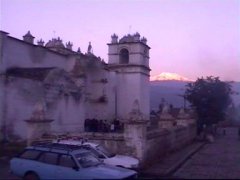 Continuation of "A TRANSLATION MEMOIR: 45 YEARS WITH CESAR VALLEJO"
Continuation of "A TRANSLATION MEMOIR: 45 YEARS WITH CESAR VALLEJO"Dr. Clayton Eshleman
With all of his poetry in mind now, it is worth noting that Vallejo’s poetic development is quite unusual. Based on the conventional, if well-written and passionate, rhymed verse in Los heraldos negros, the reader is completely unprepared for Trilce, which is still the most dense, abstract, and transgression-driven collection of poetry in the Spanish language. For Vallejo to have gone beyond Trilce, in the experimental sense, would have involved his own version of the made-up language one finds at the end of Huidobro’s Altazor. On one level, then, Vallejo took a step back from Trilce in his European poetry, but not as far back as Los heraldos negros. In moving from Lima to Paris, the poet hit the aesthetic honey head of the European colonial world at the moment it was being rocked by political revolution in Russia. Given the strangeness of Trilce’s language, it is possible to see him forming some sort of relationship with French Surrealism (the first Manifesto having appeared a year after he arrived). However, Vallejo had nothing but contempt for Surrealism which he seems to have regarded as Antonin Artaud did: an amusing parlor-game, more concerned with pleasure and freedom than with suffering and moral struggle. The advance in the European poetry is into an ontological abyss, which might be briefly described as follows:
Man is a sadness-exuding mammal, self-contradictory, perpetually immature, equally deserving of hatred, affection, and indifference. His anger breaks any wholeness into warring fragmentation, and its only redeeming quality is that it is, paradoxically, the weapon of the poor, impotent against the military resources of the rich. Man is in flight from himself: what once was an expulsion from paradise has become a flight from self, suffered in body as the worlds of colonial culture and colonized oppressiveness ambivalently intersect. At the core of life’s fullness is death, the “never” we fail to penetrate. “always” and “never” are the infinite extensions of “yes” and “no.” Sorrow is the defining tone of human life. Poetry thus becomes the expression of the irresolvability of the contradictions of man as an animal, divorced from nature as well as any sustaining faith, and caught up in the trivia of socialized life.
I have thought more about poetry while translating Vallejo than while reading anyone else, and if my own writing has been influenced by him, such influence is indirect: via what I have turned him into in English. He taught me that contradiction is an aspect of metaphor and gave me permission to try anything in my quest for an authentic alternative world in poetry.
I think that the key Vallejo lesson today may lie in a poet learning how to become imprisoned, as it were, in global life as a whole, and in each moment in particular. Human Poems in particular urges the poet to confront his own destiny and to stew in what is happening to him and to also believe that his bewildering situation is significant. To be bound to, or imprisoned in, the present, includes confronting not only life as it really is but psyche as it really is not—weighing all affirmation against, in an American’s case, our imperial obsessions and one’s own intrinsic dark.
Ypsilanti, February 2005